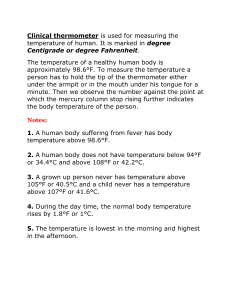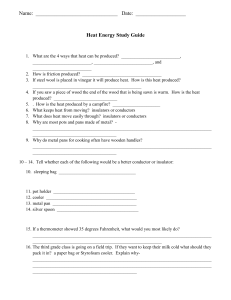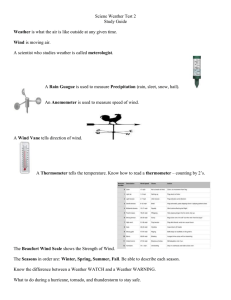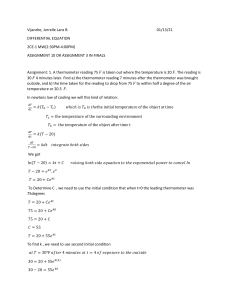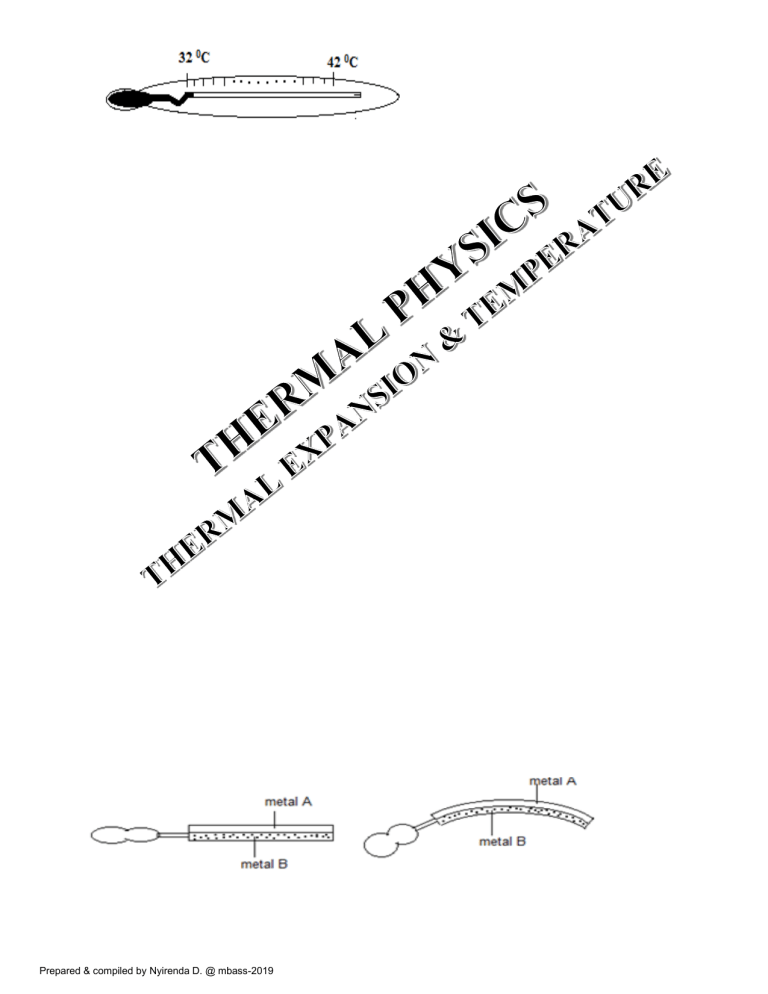
Prepared & compiled by Nyirenda D. @ mbass-2019 THERMAL EXPANSION Generally, when heat is supplied to a body, the body increases is size and when it is cooled, it decreases in size. This increase in size of the object when it is heated is called thermal expansion. On the other hand, the decrease in size of the object when it is cooled is called thermal contraction. THERMAL EXPANSION OF SOLIDS Generally, when a solid is heated, it expands (increases in size) and when cooled, it contracts (reduces in size). When a solid is heated, its expansion occurs in three dimensions. i.e. (i) increase in its length called linear expansion (ii) increase in its cross-sectional area called area or superficial expansion (iii) increase in its volume called cubical expansion NOTE: The increase in size of a solid when it is heated results from the increase in distance between its particles due to the weakening of its forces of attraction by heat energy. The increase in size of a solid when it is heated also results from the increase in the extent of vibration of its particles due to the increase in kinetic energy by heat energy Demonstration of linear, area and cubical expansion 1. Linear expansion: The increase in length of a solid when it is heated can be demonstrated as follows: Materials: metal gauge metal bar source of heat Method: (i) Before the metal bar is heated, try to pass it through the metal gauge and write your observation (ii) Heat a metal bar for a few minutes and then try to pass it through the metal gauge again. Write your observation Observation: The metal bar passes through the metal gauge before it is heated, but, it fails to pass through it after it is heated as illustrated in figures 1.0 (a) and (b); Conclusion: The metal bar undergoes linear expansion after it is heated Prepared & compiled by Nyirenda D. @ mbass-2019 2. Area (superficial) expansion: The increase in cross-sectional area of a solid when it is heated can be demonstrated as follows: Materials: metal gauge with a hole at the edge metal bar source of heat Method: (i) Before the metal bar is heated, try to pass it through the hole of a metal gauge and write your observation (ii) Heat a metal bar for a few minutes and then try to pass it through the hole of the metal gauge again. Write your observation Observation: The metal bar passes through the metal gauge before it is heated, but, it fails to pass through it after it is heated as illustrated in figures 2.0 (a) and (b); Conclusion: The metal bar undergoes area (superficial) expansion after heated 3. Volume (cubical) expansion The increase in volume of a solid when it is heated can be demonstrated as follows: Materials: metal ball and ring apparatus source of heat Method: (i) Before the metal ball is heated, try to pass it through the ring and write your observation (ii) Heat a metal ball for a few minutes and then try to pass it through the ring again. Write your observation Observation: The metal ball passes through the ring before it is heated, but, it fails to pass through it after it is heated as illustrated in figures 3.0 (a) and (b); Prepared & compiled by Nyirenda D. @ mbass-2019 Conclusion: The metal ball undergoes volume (cubical) expansion after heated EFFECTS AND APPLICATION OF THERMAL EXPANSION IN SOLIDS 1. Gaps in railway lines: Railway tracks expand on hot days and if no gaps are left to allow for expansion, it is very dangerous. The train can derail because of an expanded rail track and endanger passengers. Space is left between railway tracks as shown in figure 4.0 to allow for their expansion when temperature increases, otherwise the rails may buckle. Fig. 4.0; gaps between rails 2. Roller bearings on steel bridges: Similarly, long steel bridges are designed to include expansion joints to allow for their expansion by fixing one end and resting on other end on rollers as shown in figure 5.0. 3. Loose overhead cables: Overhead electric cables and telephone lines expand during hot days and contract during (become taut) during cold days. They are hung loosely on pylons and electric poles to allow for expansion and contraction. Prepared & compiled by Nyirenda D. @ mbass-2019 4. Small gaps in concrete structures: Concrete structures such as roads, bridges and paths expand when heated and contract when cooled. Small gaps are left every few metres in the concrete structures to allow for expansion and contraction, otherwise, they could develop cracks become weak. 5. Looped pipes: Pipes carrying water or steam are looped at intervals to allow for expansion, or else, the pipes will burst. 6. Thin and pylex glass: Glass tends to crack when heated or cooled rapidly. Consider the effect of very hot water poured into a bottle made of thick glass. The inside is heated first and tends to expand while the outside of the glass is still cool and unexpanded. This causes the glass to crack. Thin glass vessels such as laboratory beakers and flasks are less likely to crack because they are made of thin glass which is more easily heated throughout so that all parts expand together. Pylex glass expands little when heated and so does not easily crack. These are often preferred to use for heating purposes. 7. Fitting axles to wheels: While making train wheels, a steel axle is fitted onto a steel wheel by making the axle slightly too large to fit the hole in the wheel and then dipping it into liquid air at about -183 0C so that it contracts. The contracted axle will fit into the wheel and as it regains its normal temperature it expands and fits firmly into the hole. 8. A bimetallic strip: If strips of any two metals that expand unequally are fixed together, they form a bimetallic strip or compound bar as shown in figure 6.0. If such a bar is heated, because one metal (A) expands more than the other (B), the bar bends with the more expansible metal on the outside of the curve. Brass or copper expands and contracts more than steel or iron. Supposing metal ‘A’, in figure 6.0 is brass or copper and metal ‘B’ is steel or iron, such a bimetallic strip when heated will bend downwards and when cooled will bend upwards. Bimetallic strips can be used to compare the expansivity of different metals and also in many other uses as described below; Thermostat A bimetallic strip is used in making a thermostat. A thermostat is a device used to control the source of heat so that heated object is kept at a constant temperature. For example, supposing the temperature in a brooder (a house for chicks) has to be kept at 30 0C. This can be done by an electric light bulb placed in a brooder if we can cause it to be switched off whenever the temperature in the brooder Prepared & compiled by Nyirenda D. @ mbass-2019 reaches 30 0C and to be switched on again whenever the temperature drops below 30 0C. This switching on and off is done by a thermostat like the one shown in figure 7.0; 9. Loosening a jammed stopper or metal part: Thermal expansion can be useful in loosening a stopper which has become tightly jammed in the neck of the bottle. Warm the bottle neck; the expansion of the glass makes it possible to remove the stopper inside it. A similar method may be used in garage, when one metal part has become solidly jammed inside another. 10. Joining materials by riveting: Contraction or cooling is made use of in the process of riveting. A rivet is a metal pin used to fasten pieces of a metal together. The rivet is placed in a fire or flame until it is red hot, and then quickly carried with a pair of tongs, pushed through the holes in two metal plates to be joined together and hammered flat. As the rivet cools, it contracts, pulling the plates firmly together. Most steel ships and many other large structures made of steel are rivet structures. Figure 8.0 shows how riveting is done; EXPANSION OF LIQUIDS Generally, when liquids are heated they expand and when cooled they contract. The expansion of liquids results from the increase in distance between the particles due to the weakening of the forces of attraction by heat. It also results from the increase in translational movement of the particles. Expansion of liquids can be demonstrated as follows; Materials: Flat-bottomed flask Water Tripod stand Wire gauze Prepared & compiled by Nyirenda D. @ mbass-2019 rubber bang glass tube source of heat Method: (i) Arrange the apparatus as shown in figure 9.0; (ii) Apply heat to the flask and write your observation on the changes of the water level in the glass tube. Note: Since water is colourless, it has to be coloured so that it is more visible in the glass tube. Observation: When heat is applied to the flask, after a few minutes, the water level in the tube drops slightly before it starts to rise. Thereafter, the water level in the tube continues to rise as long as heat is being is applied. When heat is removed from the flask, the level of water in the tube starts to drop gradually. Conclusion: Liquids expand when heated and contracts when cooled. Comparing the expansion of liquids the comparison of the expansion of liquids is done as follows; Materials: water bath source of heat different liquids flat-bottomed flasks glass tubes rubber bang Prepared & compiled by Nyirenda D. @ mbass-2019 Method: (i) set the apparatus as shown in figure 10.0; Note: The liquids put in the flasks must be of the same volume and at the same initial levels in the glass tube. The flasks containing the liquids must be put in the water bath so that they receive the same amount of heat. Observation: When heat is applied to the liquids through a water bath, the liquids start to expand which is shown by the rise in their levels in the glass tube. Mercury shows the highest level followed by ethanol and water shows the lowest level. This simply means that that mercury expands the most followed by ethanol and water expands the least. Conclusion: Mercury expands more than water and ethanol Explanation: Mercury being a metal responds quickly to heat and therefore, expands the most. Ethanol expands more than water because ethanol has weaker forces of attraction between its particles than water. Anomalous (unusual) expansion of water When a cube of ice is heated, it expands till it starts melting. During melting, its temperature remains 0 0C but its volume decreases. If water is continuously heated from 0 0C to 4 0C, it contracts-its volume decreases and its density increase. When it is heated above 4 0C it expands-its volume increases and its density reduces. Cooling water from 4 0C to 0 0C, water expands-its volume increases and its density reduces. Therefore, water has a greatest density at 4 0C. The value of this greatest density is 1.0 g/cm3 or 1000.0 kg/m3. Effects of anomalous expansion of water; 1. Preservation of aquatic life The anomalous expansion of water helps preserve aquatic life during cold weather. When temperature falls, the top layer of water in a pond contracts, becomes denser and sinks to the bottom. A circulation is thus set up until the entire water in the pond reaches its maximum density at 4 0C. If the temperature falls further, the top layer expands and remains on the top till it freezes. Thus, even though the upper layer is frozen, the water near the bottom is at 4 0C and the fish and other aquatic life survive in it easily. Prepared & compiled by Nyirenda D. @ mbass-2019 2. Bursting of water pipes in very cold weather In a very cold climate, if the water in pipes freezes, it may split the pipe. To prevent this, pipes and taps in exposed positions should be wrapped with a material which is poor conductor of heat like strips of blanket material in order to prevent the water in the pipes from losing heat and causing it to freeze. 3. The killing of plants due to frost in cold climate Some plants in very cold climates are killed because the watery fluids in the plant cells freeze and expand causing the cell walls to burst. 4. Breaking or bursting of bottled or canned liquid food; Water is a main component in most bottled or canned liquid food. That is why companies that bottle all kinds of liquid food leave some space when filling up their bottles or cans. If no allowance is left for expansion, the bottles burst. TEMPERATURE Temperature is defined as a measure of the hotness or coldness of an object. In short, temperature is a measure of heat energy. The SI unit for temperature is the Kelvin, K, but, it is also measured in other units such as degrees Celsius, 0C, and Fanren heit, 0F. THE KELVIN SCALE Another scale used in science for measuring temperature is the Kelvin scale, named after a scientist called Lord Kelvin. He first suggested the use of the gas thermometer for accurate temperature reading. On this scale, the absolute zero temperature is equal to -273.15 0C. The absolute zero temperature is the coldest possible temperature. At absolute zero temperature, the particles which make up substances have their lowest possible energy. When a sample of a gas at constant volume is heated, its pressure is proportional to its temperature as shown in figure 11.0; Extrapolation of the graph suggest that the pressure of the gas would become zero at -273 0C. This is called the absolute zero temperature (0 K) on the Kelvin scale. It is useful to be able to convert from degrees Celsius to Kelvin units and vice versa using the following equation; TK = T 0C + 273 Prepared & compiled by Nyirenda D. @ mbass-2019 THERMOMETER A thermometer is an instrument which is used to measure temperature. A thermometer uses a physical property of matter which varies (changes) uniformly with temperature. The table below shows the types of thermometers and the physical properties of matter used to measure to temperature; Physical property of matter Type of thermometer Volume of a liquid such as mercury and ethanol Liquid-in-glass thermometer Resistance of a metal Resistance thermometer Volume of a solid Bimetallic strip thermometer Pressure of a fixed mass of a gas at constant volume Pressure at constant volume thermometer Electromotive force (e.m.f) thermocouple LIQUID-IN-GLASS THERMOMETERS This is a type of a thermometer which uses the volume of the liquid to measure temperature. Examples of such liquids which are used in liquid-in-glass thermometer include; mercury and ethanol. Advantages of using mercury in liquid-in-glass thermometer (i) It is does not stick to the glass (ii) It has high boiling point of about 357 0C and therefore, can be used to measure high temperatures (iii) It responds more quickly to heat as it is a metal and hence a good conductor of heat (iv) It expands uniformly (v) It is coloured or opaque and therefore, it is easy to see Disadvantages of using mercury in liquid-in-glass thermometer (i) It is expensive (ii) It is poisonous (iii) It has a high freezing point of about -39 0C and therefore, cannot be used to measure lower temperatures. Advantages of using ethanol in liquid-in-glass thermometer (i) It is cheaper (ii) It is safe (iii) It has a low freezing point of about -114 0C and therefore, can be used to measure lower temperatures. Disadvantages of using mercury in liquid-in-glass thermometer (i) It stick to the glass (ii) It has low boiling point of about 78 0C and therefore, cannot be used to measure high temperatures (iii) It does not respond quickly to heat as it is a covalent compound and hence poor conductor of heat (iv) It has non-uniform expansion (v) It is colourless therefore, it is not easy to see. It needs to be coloured Prepared & compiled by Nyirenda D. @ mbass-2019 CALIBRATING / GRADUATING A LIQUID-IN-GLASS THERMOMETER In order to calibrate or graduate a liquid-in-glass thermometer, we use a lower and upper fixed point. Lower fixed point is a temperature of pure melting ice, i.e. 0 0C. On the other hand, an upper fixed point is a temperature of steam from pure boiling water, i.e. 100 0 C. Determining the position of the lower fixed point on the ungraduated thermometer (i) Put the bulb of the thermometer in a funnel containing pure melting ice as shown in figure 11.5; The level of the liquid in the thermometer falls until it remains at the melting point of ice, i.e. 0 0C. (ii) Mark the position of the liquid level in the thermometer and then remove it from the melting ice. (iii) Measure the distance from the bulb to the position of the lower fixed point and record it as L0 oC, i.e. length of the liquid at 0 0C. Determining the position of the upper fixed point on the ungraduated thermometer (i) Put the bulb of the thermometer in a hypsometer which contains boiling water as shown in figure 13.0; Make sure that the bulb of the thermometer does not touch the boiling water, but, suspended in steam. The level of the liquid in the thermometer rises until at a particular point where it remains constant corresponding to the temperature of steam from the boiling water which is 100 0C Prepared & compiled by Nyirenda D. @ mbass-2019 The manometer measures the atmospheric pressure which should be equal to the steam pressure when water boils. (ii) Mark the position of the upper fixed point on the thermometer and remove it from the apparatus. (iii) Measure the distance from the bulb of the thermometer to the position of the 100 0C. Record it as L100 oC, i.e. length of the liquid at 100 0C. i.e. Linterval = L100 oC - L0 oC Find the length interval by subtracting L0 oC from L100 oC Find the temperature interval by subtracting the lower fixed point (i.e. 0 0C) from the upper fixed point (i.e. 100 0C). i.e. Tinterval = 100 0C - 0 0C = 100 0C In a space of the length interval (i.e. Linterval), make one hundred (100) equal divisions where a division would correspond to a temperature of 1 0C as shown in figure 13.0; Calculation of unknown temperature on the ungraduated thermometer You can calculate the value of the unknown temperature on the ungraduated using the following formula; Unknown temperature = 𝒄𝒉𝒂𝒏𝒈𝒆 𝒊𝒏 𝒍𝒊𝒒𝒖𝒊𝒅 𝒍𝒆𝒗𝒆𝒍 𝒍𝒆𝒏𝒈𝒕𝒉 𝒊𝒏𝒕𝒆𝒓𝒗𝒂𝒍 x temperature interval Where; unknown temperature = ⱷ Change in liquid level = Lⱷ - L0 oC Length interval = L100 oC - L0 oC Temperature interval = 100 0C Then; 𝑳 −𝑳 ⱷ = 𝑳 ⱷ −𝟎𝑳𝒐𝑪 x 100 0C 𝟏𝟎𝟎 𝒐𝑪 𝟎 𝒐𝑪 Solved problems 1. In an experiment to graduate a thermometer, the upper and lower fixed points are determined at 1cm and 5 cm respectively. Calculate…. (a) The temperature on the thermometer when the liquid level is 9 cm from the bulb (b) The liquid level when the temperature reading is 90 0C Soln. (a) Data ⱷ =? L100 oC = 15 cm; Lⱷ= 9 cm; L0 oC = 5 cm; Tinterval = 100 0C Prepared & compiled by Nyirenda D. @ mbass-2019 ⱷ=𝑳 𝑳ⱷ − 𝑳𝟎 𝒐𝑪 − 𝑳𝟎 𝒐𝑪 𝟏𝟎𝟎 𝒐𝑪 x 100 0C 9 cm − 5 cm ⱷ = 15 cm − 5 cm x 100 0C 4 cm ⱷ = 10 cm x 100 0C ⱷ = 40 0C (b) Data ⱷ = 90 0C; Lⱷ=? L0 oC = 5 cm; L100 oC = 15 cm; Tinterval = 100 0C 𝑳ⱷ − 𝑳𝟎 𝒐𝑪 ⱷ=𝑳 𝟏𝟎𝟎 𝒐𝑪 90 0C = − 𝑳𝟎 𝒐𝑪 𝑳ⱷ − 5 cm 15 cm − 5 cm 𝑳ⱷ − 5 cm 90 0C = 10 cm x 100 0C x 100 0C x 100 0C 900 cm 0C = 100 0C𝑳ⱷ -500 cm 0C 100 0C𝑳ⱷ = 900 cm 0C + 500 cm 0C 100 0C𝑳ⱷ = 1400 cm 0C 𝑳ⱷ = 14 cm 2. In an experiment to graduate a resistance of a metal thermometer, the upper and lower fixed points where determined at 404 Ω and 400 Ω respectively. Calculate….. (a) The temperature on the thermometer when the resistance of the metal is 403 Ω (b) The resistance of the metal when the temperature reading is 25 0C Soln. (a) Data ⱷ =? R100 oC = 404 Ω; Rⱷ= 403 Ω; R0 oC = 400 Ω; Tinterval = 100 0C ⱷ=𝑹 𝑹ⱷ − 𝑹𝟎 𝒐𝑪 𝟏𝟎𝟎 𝒐𝑪 ⱷ= − 𝑹𝟎 𝒐𝑪 x 100 0C 403 Ω − 400 Ω 404 Ω − 400 Ω ⱷ= 3Ω 4Ω x 100 0C x 100 0C ⱷ = 75 0C (b) Data ⱷ = 25 0C; Lⱷ=? L0 oC = 400 Ω; L100 oC = 404 Ω; Tinterval = 100 0C ⱷ=𝑹 𝑹ⱷ − 𝑹𝟎 𝒐𝑪 𝟏𝟎𝟎 𝒐𝑪 25 0C = − 𝑹𝟎 𝒐𝑪 𝑹ⱷ − 400 Ω 4Ω x 100 0C x 100 0C 100 Ω 0C = 100 0C𝑹ⱷ -40 000 Ω 0C Prepared & compiled by Nyirenda D. @ mbass-2019 100 0C𝑹ⱷ = 100 Ω 0C + 40 000 Ω 0C 100 0C𝑹ⱷ = 40100 Ω 0C 𝑹ⱷ = 401 Ω TYPES OF LIQUID-IN-GLASS THERMOMETER There are two types of liquid-in-glass thermometers. These are; 1. Laboratory thermometer: Figure 14.0 shows the structure of a laboratory thermometer; Every feature of the laboratory thermometer is designed in such a way that it increases the sensitivity of the thermometer. The table below shows the design of each feature and how it increases the sensitivity of the thermometer; FEATURE PURPOSE thin glass bulb so that heat is quickly transferred to the liquid small glass bulb to contain a small amount of a liquid which would respond quickly to heat. narrow bore to ensure that there is a noticeable movement in the liquid thread for a small change in temperature thick glass stem it acts as a magnifying glass for the liquid thread Wide range scales (i.e. 120 0C) to measure a wide range of temperatures of solutions in the laboratory the back of the scale is painted So as to see the liquid thread as well as the readings easily. vacuum To allow a complete expansion of liquids as there is no built up of air pressure Prepared & compiled by Nyirenda D. @ mbass-2019 2. Clinical thermometer: Figure 15.0 shows the structure of a clinical thermometer; Every feature of the clinical thermometer is designed in such a way that it increases the sensitivity of the thermometer. The table below shows the design of each and how it increases the sensitivity of the thermometer in addition to those discussed under laboratory thermometer; FEATURE PURPOSE constriction to prevent a sudden backflow of the liquid Short range scale it is used to measure the temperature of human being’s body whose normal temperature is between 35 0C and 37 0C Oval shaped glass stem in to magnify the liquid thread Differences between laboratory and clinical thermometers Laboratory thermometer Clinical thermometer No constriction It has a constriction Wide range of temperature scale Short range of temperature scale SENSITIVITY, RANGE, AND RESPONSIVENSEE OF LIQUID-IN-GLASS THERMOMETER 1. Sensitivity: the change in reading of the thermometer for a small change in temperature. If the reading of the thermometer has a noticeable change in liquid thread for small change in temperature, the sensitivity is high. The sensitivity of a liquid-in-glass thermometer can be increased by; (i) narrowing the bore tube (ii) enlarging the bulb 2. Range: the span of temperature that the thermometer can measure. The range of a thermometer is determined by subtracting the minimum temperature from the maximum temperature that the thermometer can measure. For example; (i) Laboratory thermometer; range = 110 0C –(-10 0C) = 120 0C (ii) Clinical thermometer; rang = 42 0C – 35 0C = 7 0C 3. Responsiveness: the ability of the thermometer to give a reading in a short time. In order to get a thermometer quick-acting, its bulb should be made of thin glass and its stem should be made of thin glass so that heat can get through easily. Prepared & compiled by Nyirenda D. @ mbass-2019 THERMO COUPLE A thermometer is a thermometer which uses thermo-electric effect to measure to temperature. It is made up of two different metals joined together at their ends. One junction is kept at constant temperature of pure melting ice (i.e. 0 0C) and the temperature of the other junction is increased by means of a Bunsen burner as shown in figure 16.0; When the junctions are kept at different temperatures, electric current flows through the metals. The larger the difference in temperatures between the junctions, the larger is the electric current produced. The milli-ampere (mA) meter reads the value of temperature directly. It is initially calibrated using the melting point of pure ice (i.e. 0 0C) and the boiling of pure water (i.e. 100 0C) A series connection of thermo couples form a thermo pile. Advantages of thermo couple over liquid-in-glass thermometer (i) It is made of metals with higher melting points and therefore, can be used to measure very high temperatures such as temperatures of a furnace or kiln. (ii) It is very sensitive to temperature changes and therefore, can be used to measure rapidly changing temperatures. (iii) It can measure a wide range of temperatures EXERCISE 1. In an experiment to calibrate a liquid-in-glass thermometer, the lower and upper fixed points were determined at 3 cm and 13 cm respectively. Calculate… (a) the temperature reading when the liquid thread is at 7 cm (b) length of the liquid thread when the temperature is 80 0C 2. In an experiment to calibrate a thermo couple thermometer, the electric current at lower and upper fixed points were determined as 4.0 A and 4.4 A respectively. Calculate… (c) the temperature reading when the electric current reading is 4.2 A (d) the value of the electric current when the temperature is 75 0C Prepared & compiled by Nyirenda D. @ mbass-2019
